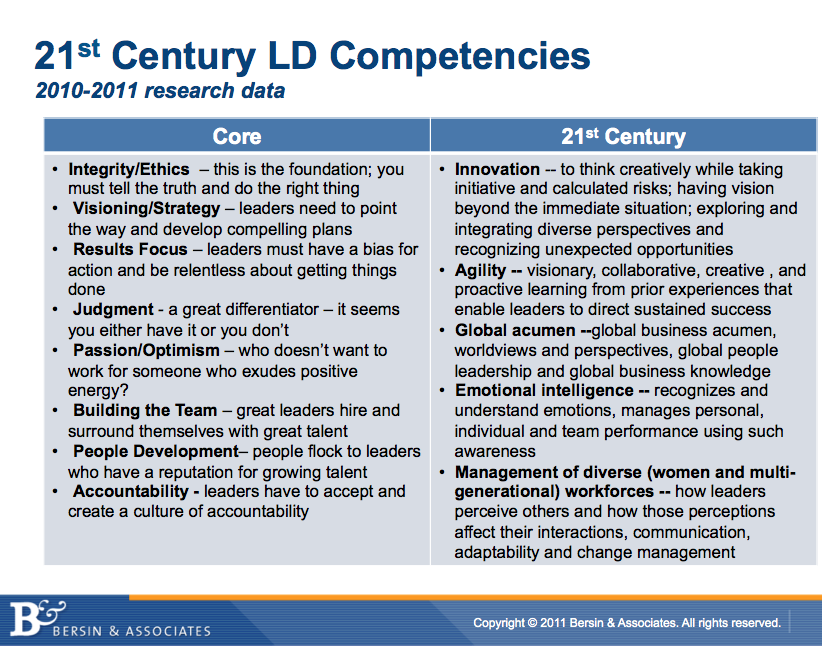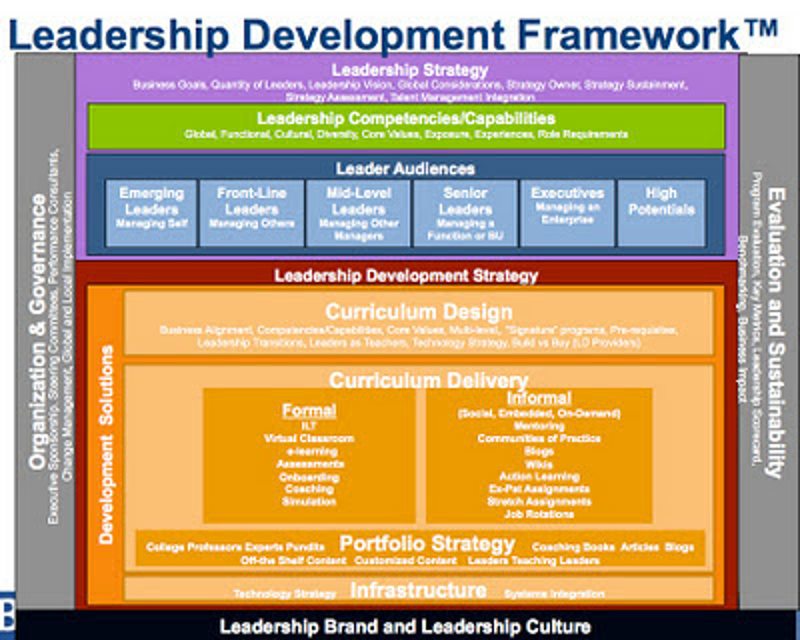I attended a really interested webinar last week sponsored by ERE.com entitled “Developing 21st Century Leaders Who Make A Difference”. It was led by Barb Loew-Arth of Bersin and Associates, a research organization focused on HR. It asked “Is leadership development a real differentiator to an organization’s business goals? If so, what business impact does it return?”
They polled nearly 300 people in the Learning and Development / Leadership field and then had 20 interviews with those having the most advanced practices. The asked:
• What are the components of modern-day leadership development?
• What does leadership development maturity look like?
• What are best practices for leadership development?
• What are the key capabilities required for effective 21st century leaders?
• Which leader levels are companies targeting for leadership development?
• How important is a leadership development strategy to leadership development?
• How do effective organizations govern, communicate about and support leadership development?
Key learnings:
Everyone is struggling with developing and retaining enough leaders, but specifically managers and Director level employees, to help (a) launch new products and services (b) expand into new markets and (c) accelerate innovation.
Organizations, just like people, achieve a sufficient leadership pipeline when they’re doing many things properly and in an aligned way (see Bersin’s framework above). Specifically, the six best practices of leadership development are:
– Executive Engagement – The Exec team needs to see this as an important piece of their overall plans for the organization. They should be involved with program focus, teaching, reviewing results, and helping evolve it over time. If it’s an HR program only, it will not have the impact.
– Business Alignment – The best programs are tightly linked, and measurable, to specific business areas. How does a course, or stretch assignment, or coaching program, help this leader grow revenue or customer satisfaction? Do the numbers pre and post programs show progress on the metrics most important to that organization? Not everything needs to be measurable, but there are plenty of appropriate measures to gauge ROI.
– Leadership Competencies – Great leadership is going to be defined differently for someone working at an airport than someone working at a high tech company, and the most powerful forms of leadership translate your organization’s external brand into something your managers can live on a daily basis. I’d add that fewer are better (~3) based on neuroscience research into our 30 seconds or so of verbal recall/memory and consider taking your organizational values and describing them using leadership behaviours. Lots of organizations have value statements which are then used in parallel with leadership competency tools, but I think that if you have well articulated, unique values then you can have one tool that links values with supporting leadership behaviours (you’ll need a little something extra for core people management skills but most core leadership skills are just as helpful to individual contributors).
– Developing leaders at all levels of the organization – Leadership is a way of being, not a level within an organization, so find ways to grow everyone’s capabilities. The easiest and least expensive tool to do this? 360 feedback with some help from a trained HR person.
– Talent Management Integration – To what extent does your organization integrate leadership development with performance management, succession planning, learning and development, recruiting, compensation, and workforce planning? High potential employees are a perfect example of identifying and then accelerating their capacity through integrated talent management solutions.
– Targeted Solutions – Different skills will take different solutions, so use a combination of ~ 70% on the job learning, 20% mentoring/relationships/learning via others, and only 10% explicit learning (classes, books, etc). Make sure to define and track metrics that define desired business and talent results.
So how do all of these link to best practices for leadership development? The graphic below gives you a sense:
Getting to something this sophisticated takes many years and lots of talented people. An actionable first step is to assess your organization against the six best practices:
Finally, they recommended leadership competencies or skills especially important for the 21st century:

As I said before, I’m super cautious about generic leadership competencies but what I liked about this slide are the skills on the right: innovation, agility, global acumen, emotional intelligence, and comfort and success with diverse people. As the world moves faster, and competition increases, it requires people to exhibit the skills on the right much more than the past.
Inspired to think about your organization’s leadership? I’d love to help you!
Photo Credit: ThisisEngineering RAEng
—
Adaptive Talent is a talent consultancy designed to help organizations achieve amazing results and ongoing adaptability. Founded in 2008 and based in Vancouver, Canada we offer retained search, assessments, total rewards consulting, training, leadership coaching and development programs, and culture & organizational development consulting.





